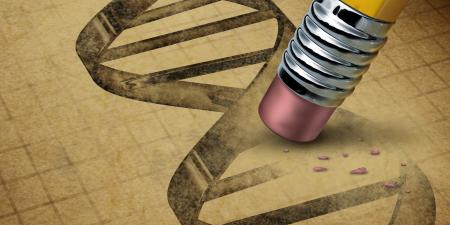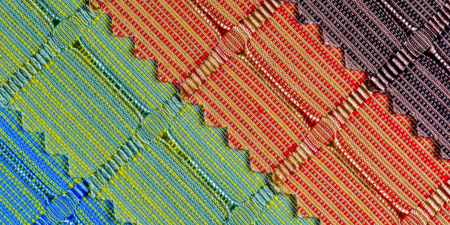Abstract
Genome editing holds tremendous promise for preventing, ameliorating, or even curing disease, but a thorough discussion of its bioethical and social implications is necessary to protect humankind against harm, a central tenet of the original Hippocratic Oath. It is therefore essential that medical students, physicians, and all health care workers have a working understanding of what gene editing entails, the controversy surrounding its use, and its far-reaching clinical and ethical implications.
Gene Editing’s Promise
“Have no fear of perfection—you’ll never reach it.” Arguably one of the closest scientific challenges to Salvador Dali’s famed proclamation came in 2012, when scientists repurposed a bacterial adaptive immune system to make precise edits to genomic DNA with astounding ease and efficiency.1 The concept of genetic engineering to modify genes has been around since the 1970s,2,3,4 but only relatively recently has its promise materialized due to the discovery of sophisticated gene editing systems. Although multiple forms of gene editing have been studied and refined (eg, zinc-finger nucleases and transcription activator-like effector nucleases),5,6 the clustered regularly interspaced short palindromic repeats (CRISPR)/Cas9 gene editing tools have bolstered the promise of correcting genetic miscues due to the relative ease and efficiency with which they can be used.7 The promise of Cas9, a bacterial-derived DNA-editing enzyme, is its ability to home in on a specific DNA sequence by using a CRISPR RNA guide sequence that is complementary to the target DNA sequence and that binds by Watson-Crick base pairing, thereby allowing Cas9 to cleave the sequence of interest.8 A CRISPR/Cas9 complex targeting the mutated Huntington gene, for example, could locate the defective DNA sequence and cut it with high accuracy, preventing production of defective Huntingtin protein.9 This technology has advanced rapidly, and a variety of other genomic modifications are now being introduced by mRNA editing and alternative splicing.10
Current Applications
Today, numerous academic and biotechnology groups are focused on the translation of CRISPR/Cas9 technology to correct a variety of genetic diseases. Derivation of induced pluripotent stem cells from patients with the targeted disease is a common model to study the capabilities of CRISPR. By targeting disease-causing mutations, somatic and germline gene editing could soon be a clinical reality for patients suffering from a variety of diseases,11,12 such as b-thalassemia,13 hemophilia A,14 cystic fibrosis,15 Duchenne muscular dystrophy,16 a1-antitrypsin deficiency,17 polycythemia vera,17 HIV-1,18 and Epstein-Barr Virus.19
In addition to preclinical work in gene editing, clinical trials are underway to target aberrantly expressed genes in a variety of disease processes, including malignancy.20 The University of Pennsylvania is currently enrolling patients for a phase I clinical trial to CRISPR-edit autologous T-cells ex vivo in an effort to target an immunogenic tumor antigen (NY-ESO-1) in relapsed refractory multiple myeloma, melanoma, synovial sarcoma, and myxoid/round cell liposarcoma.21 In late 2018, the pharmaceutical company Editas Medicine received approval from the US Food and Drug Administration for a phase I/II in vivo trial to correct a point mutation in the CEP290 gene for Leber’s congenital amaurosis type 10, the most common form of inherited childhood blindness.22
Of utmost importance is the scientific rigor with which these studies are evaluated and the publication of both positive and negative findings.
Finally, due to the shortage of organs available for transplantation, xenotransplantation—the transfer of living cells, tissues, or organs from one species to another—is being reconsidered due to advances in CRISPR editing.23 Specifically, scientists have used CRISPR/Cas9 to inactivate porcine endogenous retroviruses, thereby preventing cross-species transmission and mitigating harmful pig-to-human immune incompatibilities.24,25 These examples demonstrate the extraordinary promise of human gene editing, which raises exciting possibilities for treating a plethora of diseases but also introduces a variety of ethical and societal challenges.
Somatic vs Germline Gene Editing
An important distinction that will help guide our discussion of ethical implications of human gene editing is the difference between somatic and germline gene editing. Somatic gene editing involves making nonheritable genetic modifications to a person’s genome to treat the disease being targeted. By contrast, in germline gene editing, egg or sperm DNA is altered, and these modifications affect all subsequent cell types following fertilization and are transmitted to future generations, potentially altering the gene pool. The heritability of germline gene alterations is one of the main reasons why the World Health Organization (WHO) is developing an advisory panel to oversee and provide guidance on human gene editing,26 and it highlights the importance of reaching international consensus on appropriate uses of germline editing technologies.
Managing Risk and Hope
In 2015, just 3 years after CRISPR-Cas9 was used to cleave DNA in vitro,1 the Economist brought to life in its cover issue what many feared would become a reality with the advent of germline gene editing: eugenics via the creation of “designer babies” with enhanced features and characteristics.27 In the United States, 72% of respondents polled in 2018 said that gene editing is an appropriate use of technology to treat a serious disease or condition.28 But only 19% answered in the affirmative when asked whether this technology should be used to make babies more intelligent, underscoring the idea that these efforts should focus on treating serious illnesses.
By late 2018, gene editing suddenly faced blistering criticism when He Jiankui of China announced that, for the first time, human germline gene editing had been used to confer HIV resistance by modifying the CCR5 gene in embryos that were then implanted, producing twins.29 The choice to use germline gene editing for the purpose of preventing HIV transmission was highly controversial,30,31,32 as some have argued that the focus of human gene editing should be to serve an unmet clinical need, and the US Department of Health and Human Services notes that the risk of the virus being transmitted from mother to baby is 1% or less when a pregnant woman is treated appropriately.33 Furthermore, experiments done to render the twins immune to HIV could cause them serious harm. Some studies suggest that deletion of the CCR5 gene can potentially increase susceptibility to West Nile virus34 and tickborne encephalitis35 and have additional deleterious effects on immune responses.36 Perhaps even more importantly, the demonstration that this technology was viable in human applications without the risks being first fully considered opened up Pandora’s Box.
In March 2019, several leading gene editing experts called for a global moratorium on germline genome editing in humans37 in order to give the international community time to establish a more detailed framework by which to guide its future use. Part of the need for such a moratorium is the persistence of many uncertainties about the consequences of gene editing, such as off-target effects, or unintended cleavages of DNA sequences. There is also the chance that only some copies of targeted genes are modified, causing mosaicism.
So how should we, as medical professionals, address these concerns, and which values should guide clinical and research practice? In order to mitigate the potential adverse effects of gene editing, we need well-designed preclinical studies that support uses of gene editing for patients’ unmet clinical needs. Of utmost importance are the scientific rigor with which these studies are evaluated and the publication of both positive and negative findings. Every proposal for gene editing in human embryos that would not be brought to term should be subject to rigorous international oversight, even during study design, to ensure proper informed consent and high technical standards that motivate scientific rigor and integrity.
Because gene editing is enticing and has now actually been done in humans, organizations such as the National Academy of Sciences, Engineering and Medicine (NASEM) have set forth principles to guide somatic and germline gene editing in clinical practice and human subjects research (see Table).38,39
| Principles | Description | |||
|---|---|---|---|---|
| Promote well-being | “Providing benefit and preventing harm to those affected.” | |||
| Transparency | “Openness and sharing of information in ways that are accessible and understandable” to patients, their families, and other stakeholders. | |||
| Due care | Proceeding with research “only when supported by sufficient and robust evidence.” | |||
| Responsible science | Adhering “to the highest standards of research … in accordance with international and professional norms.” | |||
| Respect for persons | Recognizing “the personal dignity of all individuals … and respect for individual decisions.” | |||
| Fairness | Treating all cases alike, with an equitable distribution of risks and benefits. | |||
| Transnational cooperation | Committing “to collaborative approaches to research and governance while respecting different cultural contexts.” | |||
|
aAdapted from National Academies of Sciences, Engineering and Medicine.38,39
|
||||
Individual and Collective Impact
Making decisions and contributing ideas during decision making processes are important expressions of autonomy, a value that both practitioners and patients hold sacred. One central problem with human germline gene editing is that autonomy is taken away from an individual, even before birth. In a poignant piece published in Nature,40 a young girl with albinism and blindness, full of determination to play soccer, was asked if she wished her parents had corrected the genes that contributed to her genetic condition before she was born. Without a second thought she answered no. In a thought-provoking twist, their having done so might have changed her character or ambition or resulted in her being less motivated to overcome challenges. Were this question asked of someone else, that person might answer differently than she did, but it is presumptuous to think that every person would want genetic “defects” to be edited prior to birth. The perspective of persons with disabilities gives credence to the idea that germline gene editing might best serve society if used to prevent serious illnesses or fatal germline inheritance. A discussion about what separates serious from nonserious illness is perhaps an important one to have.
Because an unborn person is unable to participate in these kinds of conversations, there should be broad societal consensus about what constitutes acceptable use of germline gene editing. Furthermore, because members of different cultures hold different values, international governance of human gene editing is complex. While the aforementioned moratorium on human germline gene editing outlines key issues that should be addressed before resuming human germline gene editing experimentation, it also expresses respect for sovereign nations’ opting to resume experimentation if certain criteria are met, such as engaging the public, offering justification for national implementation plans, and attaining societal consensus before proceeding.37
Engagement With Patients and the Public
The NASEM and other scholars have identified strategies that clinicians can use to engage patients and other stakeholders in discussions of human gene editing.38,41 Communication about gene editing and its nuances should reach a broad cross-section of society, including advocacy groups, religious communities, and well and poorly educated segments of the population. Clinicians and health care workers should be able to explain the basics of gene editing and its potential uses in health care. Clinicians’ consultation with advocacy groups could also help spread information, as these groups can continue broader discussions of pertinent topics among their stakeholders. Finally, exchanges of decision-relevant information through dialogue can increase the spread of helpful information and awareness among the public. By using our platform as clinicians who care for a broad cross-section of society on a daily basis, we can help guide, inform, and grow public conversations about gene editing.
Conclusion
Despite the sometimes-negative media attention to human gene editing, scientific curiosity and discovery should not be stifled. Without bold ideas accompanied by good intentions, we would not have great scientific discoveries, such as vaccination or organ transplantation. However, bold ideas must also be accompanied by rigorous regulation to guarantee transparency, the ethical conduct and beneficial intention of gene editing studies, and protection of vulnerable patients and communities. Ultimately, as a society, we must try to carefully distinguish what is medically necessary from what is medically or socially desirable. Clinicians can have central roles in shaping these conversations.
References
- Jinek M, Chylinski K, Fonfara I, Hauer M, Doudna JA, Charpentier E. A programmable dual-RNA-guided DNA endonuclease in adaptive bacterial immunity. Science. 2012;337(6096):816-821.
-
Petherick A. Genome editing. Nature. 2015;528(7580):S1.
- Anderson ES. Viability of, and transfer of a plasmid from, E coli K12 in the human intestine. Nature. 1975;255(5508):502-504.
-
Anderson WF, Fletcher JC. Gene therapy in human beings: when is it ethical to begin? N Engl J Med. 1980;303(22):1293-1297.
- Joung JK, Sander JD. TALENs: a widely applicable technology for targeted genome editing. Nat Rev Mol Cell Biol. 2013;14(1):49-55.
- Carroll D. Genome engineering with zinc-finger nucleases. Genetics. 2011;188(4):773-782.
- Komor AC, Badran AH, Liu DR. CRISPR-based technologies for the manipulation of eukaryotic genomes. Cell. 2017;168(1-2):20-36.
- Hsu PD, Lander ES, Zhang F. Development and applications of CRISPR-Cas9 for genome engineering. Cell. 2004;157(6):1262-1278.
- Eisenstein M. CRISPR takes on Huntington’s disease. Nature. 2018;557(7707):S42-S43.
- Konermann S, Lotfy P, Brideau NJ, Oki J, Shokhirev MN, Hsu PD. Transcriptome engineering with RNA-targeting Type VI-D CRISPR effectors. Cell. 2018;173(3):665-676.e614.
-
Lockyer EJ. The potential of CRISPR-Cas9 for treating genetic disorders. Biosci Horiz Int J Stud Res. 2016;9:hzw012.
- Cai L, Fisher AL, Huang H, Xie Z. CRISPR-mediated genome editing and human diseases. Genes Dis. 2016;3(4):244-251.
- Xie F, Ye L, Chang JC, et al. Seamless gene correction of beta-thalassemia mutations in patient-specific iPSCs using CRISPR/Cas9 and piggyBac. Genome Res. 2014;24(9):1526-1533.
- Park CY, Kim DH, Son JS, et al. Functional correction of large factor VIII gene chromosomal inversions in hemophilia A patient-derived iPSCs using CRISPR-Cas9. Cell Stem Cell. 2015;17(2):213-220.
- Schwank G, Koo BK, Sasselli V, et al. Functional repair of CFTR by CRISPR/Cas9 in intestinal stem cell organoids of cystic fibrosis patients. Cell Stem Cell. 2013;13(6):653-658.
- Li HL, Fujimoto N, Sasakawa N, et al. Precise correction of the dystrophin gene in Duchenne muscular dystrophy patient induced pluripotent stem cells by TALEN and CRISPR-Cas9. Stem Cell Reports. 2015;4(1):143-154.
- Smith C, Abalde-Atristain L, He C, et al. Efficient and allele-specific genome editing of disease loci in human iPSCs. Mol Ther. 2015;23(3):570-577.
-
Zhu W, Lei R, Le Duff Y, et al. The CRISPR/Cas9 system inactivates latent HIV-1 proviral DNA. Retrovirology. 2015;12:22.
- Yuen KS, Chan CP, Wong NH, et al. CRISPR/Cas9-mediated genome editing of Epstein-Barr virus in human cells. J Gen Virol. 2015;96(pt 3):626-636.
-
NCT02793856: PD-1 knockout engineered T cells for metastatic non-small cell lung cancer [study]. ClincalTrials.gov. https://ClinicalTrials.gov/show/NCT02793856. Published June 8, 2016. Updated January 23, 2019. Accessed June 19, 2019.
-
NCT03399448: NY-ESO-1-redirected CRISPR (TCRendo and PD1) edited T cells (NYCE T cells) [study]. ClinicalTrials.gov. https://ClinicalTrials.gov/show/NCT03399448. Published January 16, 2018. Updated March 4, 2019. Accessed June 19, 2019.
-
Go-ahead for first in-body CRISPR medicine testing. Nature Biotechnology News. December 14, 2018. https://www.nature.com/articles/d41587-018-00003-2.
- Perkel JM. Xenotransplantation makes a comeback. Nat Biotechnol. 2016;34(1):3-4.
- Niu D, Wei HJ, Lin L, et al. Inactivation of porcine endogenous retrovirus in pigs using CRISPR-Cas9. Science. 2017;357(6357):1303-1307.
-
Koch L. Genetic engineering: pigs without PERVs. Nat Rev Genet. 2017;18(10):579.
-
WHO to oversee genome editing. Nat Biotechnol. 2019;37(4):338.
-
Editing humanity [editorial]. Economist. August 22, 2015. https://www.economist.com/leaders/2015/08/22/editing-humanity. Accessed June 20, 2019.
-
Funk C, Kennedy B, Hefferon M, Strauss M, Milanez I. Public views of gene editing for babies depend on how it would be used. Pew Research Center Science & Society. July 26, 2018. https://www.pewresearch.org/science/2018/07/26/public-views-of-gene-editing-for-babies-depend-on-how-it-would-be-used/. Accessed June 20, 2019.
-
Regalado A. Chinese scientists are creating CRISPR babies. MIT Technology Review. November 25, 2018. https://www.technologyreview.com/s/612458/exclusive-chinese-scientists-are-creating-crispr-babies/. Accessed June 19, 2019.
-
Topol EJ. Editing babies? We need to learn a lot more first. New York Times. November 27, 2018. https://www.nytimes.com/2018/11/27/opinion/genetically-edited-babies-china.html. Accessed June 20, 2019.
- Cyranoski D. CRISPR-baby scientist fails to satisfy critics. Nature. 2018;564(7734):13-14.
-
Normile D. Government report blasts creator of CRISPR twins. Science. 2019;363(6425):328.
-
US Department of Health and Human Services. Preventing mother-to-child transmission of HIV. https://aidsinfo.nih.gov/understanding-hiv-aids/fact-sheets/20/50/preventing-mother-to-child-transmission-of-hiv. Updated April 25, 2019. Accessed June 20, 2019.
- Glass WG, McDermott DH, Lim JK, et al. CCR5 deficiency increases risk of symptomatic West Nile virus infection. J Exp Med. 2006;203(1):35-40.
- Kindberg E, Mickiene A, Ax C, et al. A deletion in the chemokine receptor 5 (CCR5) gene is associated with tickborne encephalitis. J Infect Dis. 2008;197(2):266-269.
-
Hütter G, Neumann M, Nowak D, Klein S, Klüter H, Hofmann WK. The effect of the CCR5-delta32 deletion on global gene expression considering immune response and inflammation. J Inflamm (Lond). 2011;8:29.
- Lander ES, Baylis F, Zhang F, et al. Adopt a moratorium on heritable genome editing. Nature. 2019;567(7747):165-168.
-
With stringent oversight, heritable germline editing clinical trials could one day be permitted for serious conditions; non-heritable should be limited to treating or preventing disease or disability at this time [press release]. Washington, DC: National Academies of Sciences, Engineering, and Medicine; February 14, 2017. https://www8.nationalacademies.org/onpinews/newsitem.aspx?RecordID=24623. Accessed October 16, 2019.
-
National Academies of Sciences, Engineering, and Medicine. Human Genome Editing: Science, Ethics, and Governance. Washington, DC: National Academies Press; 2017.
-
Check Hayden E. Should you edit your children’s genes? Nature. 2016;530(7591):402-405.
- Jasanoff S, Hurlbut JB. A global observatory for gene editing. Nature. 2018;555(7697):435-437.



